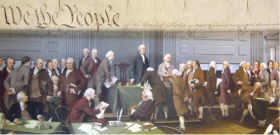The Kaleidoscopic Joys of State Constitutionalism
In addition to requiring instruction in US government and politics, Texas law requires undergraduates at state-sponsored colleges and universities to take a course “which includes consideration of the . . . constitutions of the states, with special emphasis on that of Texas.” I am pretty sure part of the department’s deliberation at Texas A&M University in favor of hiring me those many years ago touched on the fact that the statistical portion of my dissertation drew on a unique state-level data set that I developed. The main point of interest would not be the uniqueness of the data set, but rather that I dipped into state legislative records. That thin reed was sufficient to justify my habitual assignment to teach the state-mandated course in state government, a course most of the faculty in the department preferred to avoid.
And, indeed, the department’s speculation was not far wrong. The same reason that impelled me to develop and employ a state-level data set for my dissertation remains the reason I find state-level constitutionalism and institutions overall more interesting (note, not more important, but more interesting) than national-level constitutionalism: variation among the states.
As I mentioned above, I dare say that most of my colleagues, and I’ll add most of my students as well, consider the required course in state government less interesting than the required course on the US national government. Indeed, they are in good company. I only half-jokingly point my students to Alexander Hamilton comments in The Federalist No. 17 as to why Americans should not fear that the then-proposed national government would usurp state power. He writes that the objects of state government policy are so boring that they will fail to attract the attention of even the most power hungry of national politicians:
Allowing the utmost latitude to the love of power which any reasonable man can require, I confess I am at a loss to discover what temptation the persons entrusted with the administration of the general government could ever feel to divest the States of the authorities of that description. The regulation of the mere domestic police of a State appears to me to hold out slender allurements to ambition. Commerce, finance, negotiation, and war seem to comprehend all the objects which have charms for minds governed by that passion; and all the powers necessary to those objects ought, in the first instance, to be lodged in the national depository.
Hamilton may or may not be correct at the policy level (20th Century national governance might challenge his argument here), but I definitely beg to differ with him as concerns state-level constitutionalism. State constitutions are interesting for the same reason that I drew on a state-level data set for my dissertation: variation exists at the state level that does not exist at the national level.
The fun part of this variation is that state constitutional designers continue a dialogue over constitutional government not only with and among themselves, but with the national constitutional framers as well. Given that state constitutions typically are easier to amend, there has been much more experimentation and variation at the state level regarding constitutional practices and institutions, and continuing conversation and debate over optimal constitutional institutions and structures.
Better known constitutional differences include the line-item veto numerous state governors possess and different forms of direct democracy. Nebraska’s legislature, which is both a unicameral body and is elected on a non-partisan basis, is also a well-known footnote among state legislative structures. Less well known is that Minnesota elected their legislature on a non-partisan basis from 1913 until the mid-1970s. And early in the Republic, Pennsylvania, Georgia and Vermont all had unicameral legislatures.
Also well known is that many states have some form of elections for judges, aiming to provide explicit democratic accountability for the judiciary. More interesting than the mere fact of these elections is the theory animating this difference: Constitutional designers in these states intentionally rejected arguments from the nation’s founding that counseled immunizing judges from direct majoritarian accountability. Arguments continue over the “countermajoritarian dilemma” for state (and national) courts without explicit majoritarian accountability on the one hand, and the implications of the marginal loss of judicial independence that results from electoral accountability.
Somewhat less well known is the US Supreme Court’s rejection of providing advisory opinions to coordinate branches of the US government (and to other courts as well). State constitutionalists have disagreed on the wisdom of that practice. Eight state constitutions expressly permit state high courts to issue advisory opinions, two states provide statutory authorization for advisory opinions, and one state allows advisory opinions by judicial practice (although the practice hasn’t been used recently). In the past, an additional eight state high courts issued advisory opinions but subsequently ended the practice. The possibility of receiving a signal from the state’s supreme court in advance of enacting or implementing legislation can dramatically affect legislation, killing some legislation that would otherwise be enacted, and encouraging the enactment of legislation that would never have been enacted in the first place. There is a huge variety of institutional permutations among the states than could be added here.
Differences don’t simply pertain to designing the three branches of government. Take the topic of faction, the subject of perhaps what is today the best known papers of The Federalist, number 10. State constitutions have more explicitly attempted to stop factious legislation relative to the national constitution. Limitations on special legislation (with arguments over the extent to which these provisions overlap with equal protection requirements), single-subject requirements (to deter log-rolling), and uniform tax requirements (although compare article 1, section 9, clause 4 in the US Constitution, prior to the 16th Amendment) are all popular state constitutional provisions, among others, that aim to stymie factious legislative enactments.
Laid over all of the textual differences in state constitutions are differing levels of judicial application and enforcement. State judiciaries interact with decisions in other states, as well as with national constitutional framers, in seeking to provide import (or deprive import) of differing constitutional provisions.
I have yet to mention state bills of rights. Once the province of liberal activism, in recent decades conservatives have gotten in the game as well, advocating, and implementing, greater state-level protections for citizens against government takings, broader and more rigorous protection of gun rights, and more.
State constitutionalism subsists in a dialogue with constitutional designers from other states, but also continue a centuries-long conversation with the national Constitution’s framers. The conversation continues a very practical discussion of the nature of republican self-government, and is never ending. But while never ending, the argument is never boring.


